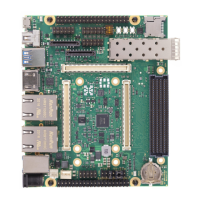transceivers.
The USB 2.0 connectivity options offer compatibility with both modules having a single USB interface (USB
controller or USB OTG support) or modules having two USB interfaces.
Appendix A describes the supported use cases and configuration examples for the available Mercury mod-
ules.
USB_MODE1 USB_MODE0 HS0 HS1/VBUS FX3 SSRX/TX MGT2/SS MGT3/SS
CFG DIP 4 CFG DIP 3 A-127/129 A-131/133 A-136/140 B-29/33 B-37/41
A-137/141 B-32/36 B-40/44
On On USB-A VBUS/ID - USB-A -
On Off USB-B VBUS/ID USB-B USB-A -
Off On USB-B USB-A - USB-B USB-A
Off Off USB-B USB-A USB-B - -
Table 25: USB Connection Table
The USB 2.0 micro B connector on the front panel is connected solely to the FTDI device. This connection
can be used for configuration or test purposes.
6.5.2 USB 2.0 Device Controller (FTDI)
The Mercury module FPGA configuration interface and QSPI flash signals are connected to the FTDI USB 2.0
device controller. This allows FPGA serial configuration and SPI flash programming over USB from a host
computer without additional hardware.
Port A of the FTDI device is used for Xilinx JTAG implementation.
Port B of the FTDI is used to access the I2C bus and the UART pins of the Mercury module, to program the
SPI Flash or to configure the FPGA in slave serial mode. General purpose I/O pins of port B (FTDI_MODE0/1)
are used to control the configuration multiplexers; refer to Table 26 for details.
By default, the UART communication between the FTDI device and FPGA is active. The Xilinx JTAG mode
can be activated using the Enclustra MCT [10] and is independent of the UART connection.
The library used by the MCT is available free of charge; it allows users to integrate module enumeration,
FPGA and SPI flash configuration, and I2C communication functionality in their own application. The library
consists of a Windows DLL with a C-style interface, allowing use of the library from almost any programming
language; for C++ applications, a C++ wrapper is also provided. Please contact Enclustra for details.
D-0000-456-001 35 / 48 Version 02, 23.07.2020

